英语时态8种基本时态讲解完善版
- 格式:doc
- 大小:44.50 KB
- 文档页数:17
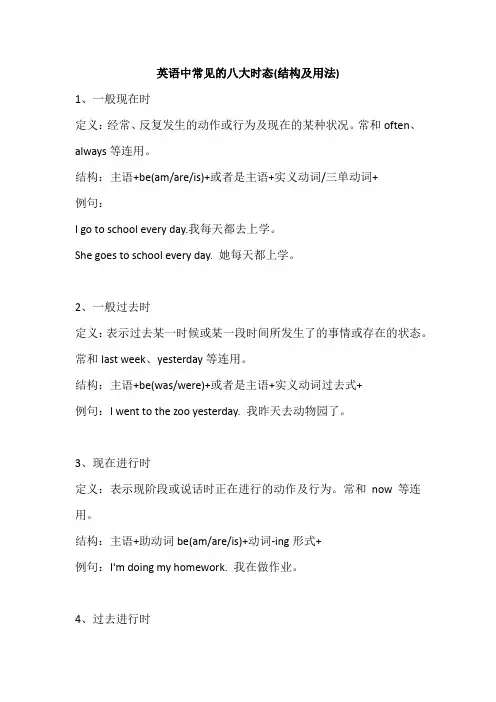
英语中常见的八大时态(结构及用法)1、一般现在时定义:经常、反复发生的动作或行为及现在的某种状况。
常和often、always等连用。
结构:主语+be(am/are/is)+或者是主语+实义动词/三单动词+例句:I go to school every day.我每天都去上学。
She goes to school every day. 她每天都上学。
2、一般过去时定义:表示过去某一时候或某一段时间所发生了的事情或存在的状态。
常和last week、yesterday等连用。
结构:主语+be(was/were)+或者是主语+实义动词过去式+例句:I went to the zoo yesterday. 我昨天去动物园了。
3、现在进行时定义:表示现阶段或说话时正在进行的动作及行为。
常和now等连用。
结构:主语+助动词be(am/are/is)+动词-ing形式+例句:I'm doing my homework. 我在做作业。
4、过去进行时定义:表示在过去某个时间点发生或进行的行为的事情。
常和at this time yesterday等或以when引导的谓语动词连用。
结构:主语+助动词be(was/were)+动词-ing形式+例句:When I got to the top of the mountain, the sun was shining. 我到达山顶时,阳光灿烂。
5、现在完成时定义:表示过去发生的动作对现在造成的影响或结果或过去的动作或状态持续到现在。
构成:主语+助动词(have/has)+动词过去分词+例句:I have lived here for more than twenty years. 我住在这儿二十多年了。
6、过去完成时定义:表示在过去某一时刻或动作以前完成了的动作,也可以说过去的时间关于过去的动作。
构成:主语+助动词(have/has)+动词过去分词+例句:She said she had never been to Paris. 她告诉我她曾去过巴黎。
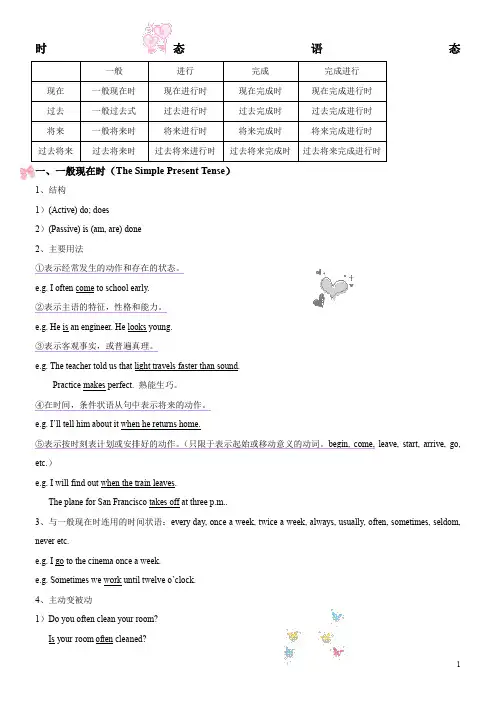
时态语态一、一般现在时(The Simple Present Tense)1、结构1)(Active) do; does2)(Passive) is (am, are) done2、主要用法①表示经常发生的动作和存在的状态。
e.g. I often come to school early.②表示主语的特征,性格和能力。
e.g. He is an engineer. He looks young.③表示客观事实,或普遍真理。
e.g. The teacher told us that light travels faster than sound.Practice makes perfect. 熟能生巧。
④在时间,条件状语从句中表示将来的动作。
e.g. I’ll tell him about it when he returns home.⑤表示按时刻表计划或安排好的动作。
(只限于表示起始或移动意义的动词。
begin, come, leave, start, arrive, go, etc.)e.g. I will find out when the train leaves.The plane for San Francisco takes off at three p.m..3、与一般现在时连用的时间状语:every day, once a week, twice a week, always, usually, often, sometimes, seldom, never etc.e.g. I go to the cinema once a week.e.g. Sometimes we work until twelve o’clock.4、主动变被动1)Do you often clean your room?Is your room often cleaned?2)People speak English in many countries.English is spoken in many countries.二、一般过去时(The Simple Past Tense)1、结构1)(Active) did2)(Passive) was/were done2、主要用法①表示过去的动作或状态。
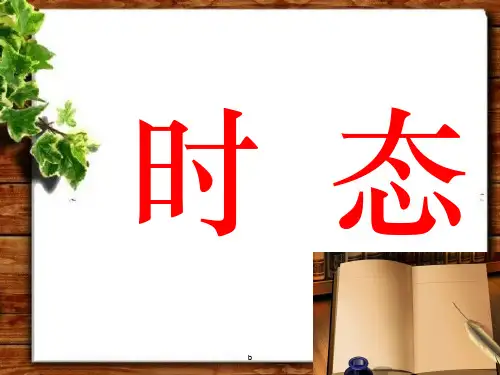
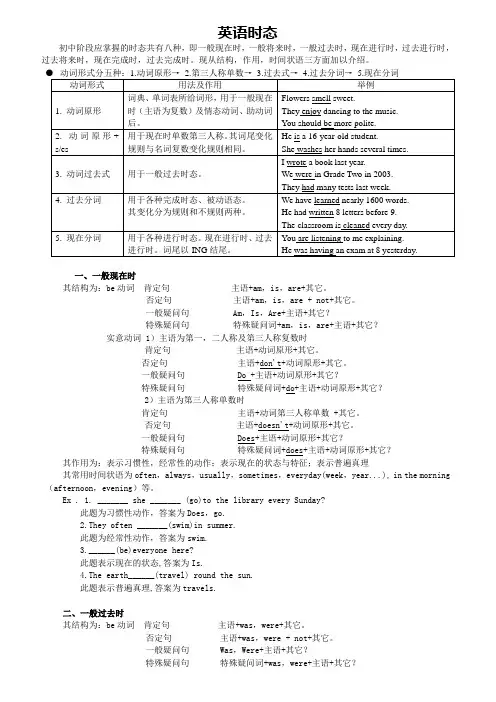
英语时态初中阶段应掌握的时态共有八种,即一般现在时,一般将来时,一般过去时,现在进行时,过去进行时,过去将来时,现在完成时,过去完成时。
现从结构,作用,时间状语三方面加以介绍。
一、一般现在时其结构为:be动词肯定句主语+am,is,are+其它。
否定句主语+am,is,are + not+其它。
一般疑问句 Am,Is,Are+主语+其它?特殊疑问句特殊疑问词+am,is,are+主语+其它?实意动词1)主语为第一,二人称及第三人称复数时肯定句主语+动词原形+其它。
否定句主语+don't+动词原形+其它。
一般疑问句 Do +主语+动词原形+其它?特殊疑问句特殊疑问词+do+主语+动词原形+其它?2)主语为第三人称单数时肯定句主语+动词第三人称单数 +其它。
否定句主语+doesn't+动词原形+其它。
一般疑问句 Does+主语+动词原形+其它?特殊疑问句特殊疑问词+does+主语+动词原形+其它?其作用为:表示习惯性,经常性的动作;表示现在的状态与特征;表示普遍真理其常用时间状语为often,always,usually,sometimes,everyday(week,year...), in the morning (afternoon,evening)等。
Ex . 1. _______ she _______ (go)to the library every Sunday?此题为习惯性动作,答案为Does,go.2.They often _______(swim)in summer.此题为经常性动作,答案为swim.3.______(be)everyone here?此题表示现在的状态,答案为Is.4.The earth______(travel) round the sun.此题表示普遍真理,答案为travels.二、一般过去时其结构为:be动词肯定句主语+was,were+其它。
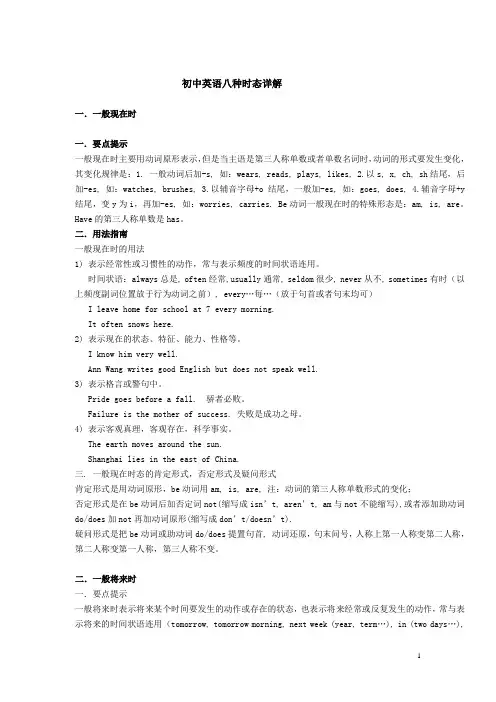
初中英语八种时态详解一.一般现在时一.要点提示一般现在时主要用动词原形表示,但是当主语是第三人称单数或者单数名词时,动词的形式要发生变化,其变化规律是:1. 一般动词后加-s, 如:wears, reads, plays, likes, 2.以s, x, ch, sh结尾,后加-es, 如:watches, brushes, 3.以辅音字母+o结尾,一般加-es, 如:goes, does, 4.辅音字母+y 结尾,变y为i,再加-es, 如:worries, carries. Be动词一般现在时的特殊形态是:am, is, are。
Have的第三人称单数是has。
二.用法指南一般现在时的用法1) 表示经常性或习惯性的动作,常与表示频度的时间状语连用。
时间状语:always总是, often经常,usually通常, seldom很少, never从不, sometimes有时(以上频度副词位置放于行为动词之前), every…每…(放于句首或者句末均可)I leave home for school at 7 every morning.It often snows here.2) 表示现在的状态、特征、能力、性格等。
I know him very well.Ann Wang writes good English but does not speak well.3) 表示格言或警句中。
Pride goes before a fall. 骄者必败。
Failure is the mother of success. 失败是成功之母。
4) 表示客观真理,客观存在,科学事实。
The earth moves around the sun.Shanghai lies in the east of China.三. 一般现在时态的肯定形式,否定形式及疑问形式肯定形式是用动词原形,be动词用am, is, are, 注:动词的第三人称单数形式的变化;否定形式是在be动词后加否定词not(缩写成isn’t, aren’t, am与not不能缩写),或者添加助动词do/does加not再加动词原形(缩写成don’t/doesn’t).疑问形式是把be动词或助动词do/does提置句首, 动词还原,句末问号,人称上第一人称变第二人称,第二人称变第一人称,第三人称不变。

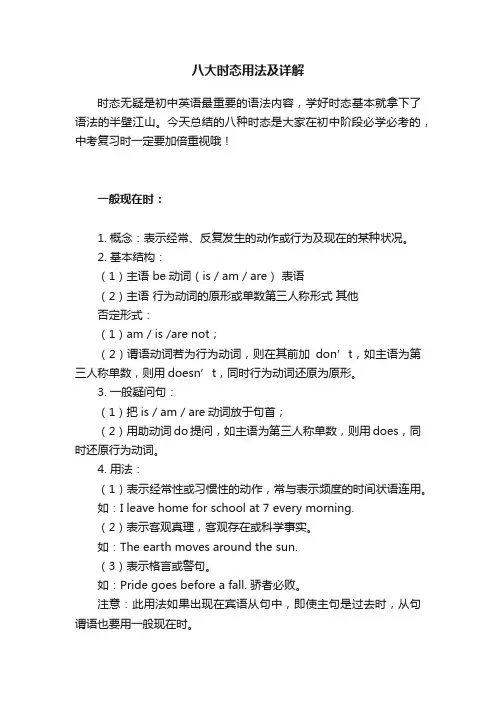
八大时态用法及详解时态无疑是初中英语最重要的语法内容,学好时态基本就拿下了语法的半壁江山。
今天总结的八种时态是大家在初中阶段必学必考的,中考复习时一定要加倍重视哦!一般现在时:1. 概念:表示经常、反复发生的动作或行为及现在的某种状况。
2. 基本结构:(1)主语 be动词(is / am / are)表语(2)主语行为动词的原形或单数第三人称形式其他否定形式:(1)am / is /are not;(2)谓语动词若为行为动词,则在其前加don’t,如主语为第三人称单数,则用doesn’t,同时行为动词还原为原形。
3. 一般疑问句:(1)把is / am / are动词放于句首;(2)用助动词do提问,如主语为第三人称单数,则用does,同时还原行为动词。
4. 用法:(1)表示经常性或习惯性的动作,常与表示频度的时间状语连用。
如:I leave home for school at 7 every morning.(2)表示客观真理,客观存在或科学事实。
如:The earth moves around the sun.(3)表示格言或警句。
如:Pride goes before a fall. 骄者必败。
注意:此用法如果出现在宾语从句中,即使主句是过去时,从句谓语也要用一般现在时。
如:Columbus proved that the earth is round.(4)表示现在时刻的状态、能力、性格、个性等。
如:I don’t want so much.Ann writes good English but does not speak well.(5)一般现在时表示将来含义① come, go, arrive, leave, start, begin, return的一般现在时可以表示将来,主要用来表示在时间上已确定或安排好的事情。
如:The train leaves at six tomorrow morning.— When does the bus star?— It stars in ten minutes.② 在时间或条件状语句中。
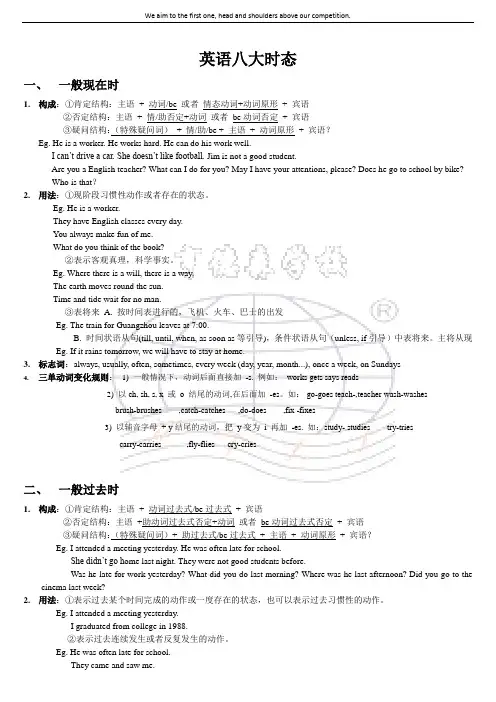
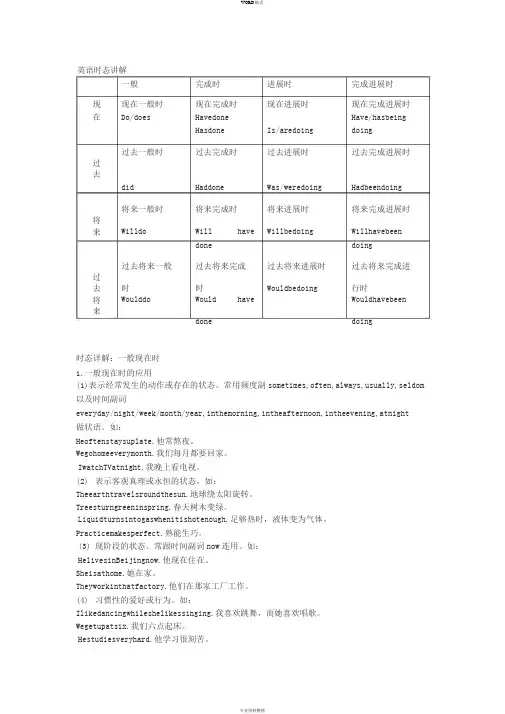
英语时态讲解一般完成时进展时完成进展时现现在一般时现在完成时现在进展时现在完成进展时在Do/does Havedone Have/hasbeingHasdone Is/aredoing doing过去一般时过去完成时过去进展时过去完成进展时过去did Haddone Was/weredoing Hadbeendoing将来一般时将来完成时将来进展时将来完成进展时将Willdo Will have Willbedoing Willhavebeen 来done doing过去将来一般过去将来完成过去将来进展时过去将来完成进过Wouldbedoing去时时行时将Woulddo Would have Wouldhavebeen 来done doing时态详解:一般现在时1.一般现在时的应用(1)表示经常发生的动作或存在的状态。
常用频度副sometimes,often,always,usually,seldom 以及时间副词everyday/night/week/month/year,inthemorning,intheafternoon,intheevening,atnight做状语。
如:Heoftenstaysuplate.他常熬夜。
Wegohomeeverymonth.我们每月都要回家。
IwatchTVatnight.我晚上看电视。
(2)表示客观真理或永恒的状态。
如:Theearthtravelsroundthesun.地球绕太阳旋转。
Treesturngreeninspring.春天树木变绿。
Liquidturnsintogaswhenitishotenough.足够热时,液体变为气体。
Practicemakesperfect.熟能生巧。
(3)现阶段的状态。
常跟时间副词now连用。
如:HelivesinBeijingnow.他现在住在。
Sheisathome.她在家。
Theyworkinthatfactory.他们在那家工厂工作。
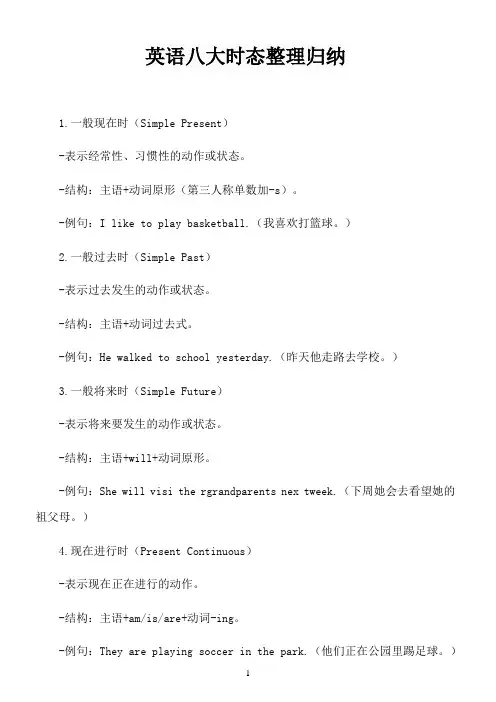
英语八大时态整理归纳1.一般现在时(Simple Present)-表示经常性、习惯性的动作或状态。
-结构:主语+动词原形(第三人称单数加-s)。
-例句:I like to play basketball.(我喜欢打篮球。
)2.一般过去时(Simple Past)-表示过去发生的动作或状态。
-结构:主语+动词过去式。
-例句:He walked to school yesterday.(昨天他走路去学校。
)3.一般将来时(Simple Future)-表示将来要发生的动作或状态。
-结构:主语+will+动词原形。
-例句:She will visi the rgrandparents nex tweek.(下周她会去看望她的祖父母。
)4.现在进行时(Present Continuous)-表示现在正在进行的动作。
-结构:主语+am/is/are+动词-ing。
-例句:They are playing soccer in the park.(他们正在公园里踢足球。
)5.过去进行时(Past Continuous)-表示过去某一时间正在进行的动作。
-结构:主语+was/were+动词-ing。
-例句:I was studying when she called me.(她给我打电话的时候,我正在学习。
)6.现在完成时(Present Perfect)-表示过去某个时间发生的动作对现在造成的影响。
-结构:主语+have/has+过去分词。
-例句:We have finished our homework.(我们已经完成了作业。
)7.过去完成时(Past Perfect)-表示过去某一时间之前已经发生的动作。
-结构:主语+had+过去分词。
-例句:He had already left when I arrived.(我到达时他已经离开了。
)8.将来完成时(Future Perfect)-表示将来某个时间之前已经完成的动作。
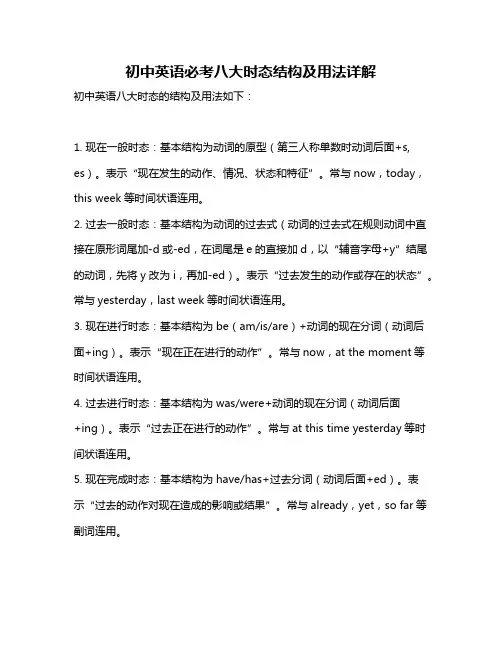
初中英语必考八大时态结构及用法详解初中英语八大时态的结构及用法如下:1. 现在一般时态:基本结构为动词的原型(第三人称单数时动词后面+s, es)。
表示“现在发生的动作、情况、状态和特征”。
常与now,today,this week等时间状语连用。
2. 过去一般时态:基本结构为动词的过去式(动词的过去式在规则动词中直接在原形词尾加-d或-ed,在词尾是e的直接加d,以“辅音字母+y”结尾的动词,先将y改为i,再加-ed)。
表示“过去发生的动作或存在的状态”。
常与yesterday,last week等时间状语连用。
3. 现在进行时态:基本结构为be(am/is/are)+动词的现在分词(动词后面+ing)。
表示“现在正在进行的动作”。
常与now,at the moment等时间状语连用。
4. 过去进行时态:基本结构为was/were+动词的现在分词(动词后面+ing)。
表示“过去正在进行的动作”。
常与at this time yesterday等时间状语连用。
5. 现在完成时态:基本结构为have/has+过去分词(动词后面+ed)。
表示“过去的动作对现在造成的影响或结果”。
常与already,yet,so far等副词连用。
6. 过去完成时态:基本结构为had+过去分词(动词后面+ed)。
表示“过去的动作在过去的某个时间之前已经完成或发生的动作或存在的状态”。
常与by the end of last year,by the time of等时间状语连用。
7. 现在完成进行时态:基本结构为have/has been+动词的现在分词(动词后面+ing)。
表示“动作从过去某时开始,一直延续到现在,或者刚刚完成”。
常与for several days,since等时间状语连用。
8. 过去完成进行时态:基本结构为had been+动词的现在分词(动词后面+ing)。
表示“过去的某个动作从过去某时开始,一直延续到过去的某个时间,或者刚刚完成”。
英语八大时态讲解英语八大时态:一般现在时一般过去时一般将来时现在进行时过去进行时现在完成时过去完成时过去将来时一、一般现在时标志:动词原形情况变形方法读音清辅音后读/s/ 浊辅音和元音后读/z/ 读/z/ 读/iz/ 读/z/ 例词 swim--swims help--helps like--likes go--goes do--does watch--watches wash--washes study--studies have--hasbe--am/is/are 一般情况 +s 辅音字母+o结尾 s/sh/ch/x等结尾辅音字母+y结尾特殊情况:have和be动词 +es +es 变y 为i+es 变have 为 has 变be为am/is/are 1. 表示经常性或习惯性动作,常与表频度的时间状语连用:She often speaks English.I leave home for school at 7 every morning. 造句练习:孩子们通常不喜欢家庭作业。
2. 表示现在的状态、特征、职业、能力、感觉等:He seems to feel a bit down today. He works as a driver.造句练习:她英语说得好。
3. 表示真理、客观存在、科学事实或用于格言警句中:Shanghai lies in the east of China.Columbus proved that the earth is round. Where there is a will, there is a way. 造句练习:地球绕太阳转动。
4. 表示现在瞬间的动作:Here comes the bus! 5. 表示将来1) 表按规定、计划、安排将要发生的动作(仅限于某些表示“来、去、动、停、开始、结束、继续”等的趋向动词),可以与表示未来的时间状语搭配使用。
常见的用法是:飞机、火车、轮船、汽车等定期定点运行的交通状况。
英语语法八大时态一.一般现在时1.结构肯定句式: 主语+动词原形/动词的第三人称单数+其他否定句式: 主语+(助动词)don't/doesn't +动词原形+其他一般疑问句式: Do/Does+主语+动词原形+其他简略回答: (肯)Yes,主语+do/does (否)No,主语+do/does not缩写形式: don't = do not doesn't = does not例句:He often goes swimming in summer.I usually leave home for school at 7 every morning.2.用法1)表示经常的、习惯性的动作或存在的状态,常与表示频度的副词连用。
常用的频度副词有:always、often、usually、seldom、never、sometimes, every week (day, year, month…), once a week, on Sundays.频度副词在句中通常放在行为动词之前,系动词、助动词之后。
例如: He often goes swimming in summer.I usually leave home for school at 7 every morning.2)表示主语具备的性格、特征和能力等。
例如:All my family love football .My sister is always ready to help others .Ann writes good English but does not speak well.3)表示客观真理、客观存在、自然现象。
例如:The earth moves around the sun.Shanghai lies in the east of China.4)表示按计划或安排好的,或将要发生的动作,可用一般现在时表将来。
初中英语语法八大时态一.一般现在时1.结构肯定句式: 主语+动词原形/动词的第三人称单数+其他否定句式: 主语+(助动词)don't/doesn't +动词原形+其他一般疑问句式: Do/Does+主语+动词原形+其他简略回答: (肯)Yes,主语+do/does (否)No,主语+do/does not缩写形式: don't = do not doesn't = does not例句:He often goes swimming in summer.I usually leave home for school at 7 every morning.2.用法1)表示经常的、习惯性的动作或存在的状态,常与表示频度的副词连用。
常用的频度副词有:always、often、usually、seldom、never、sometimes, every week (day, year, month…), once a week, on Sundays.频度副词在句中通常放在行为动词之前,系动词、助动词之后。
例如: He often goes swimming in summer.I usually leave home for school at 7 every morning.2)表示主语具备的性格、特征和能力等。
例如:All my family love football .My sister is always ready to help others .Ann writes good English but does not speak well.3)表示客观真理、客观存在、自然现象。
例如:The earth moves around the sun.Shanghai lies in the east of China.4)表示按计划或安排好的,或将要发生的动作,可用一般现在时表将来。
英语时态8种基本时态讲解一、概念:英语中表示不同时间发生得动作或存在得状态,需用不同得动词形式表示,这种不同得动词形式称为时态。
二。
种类:(基本时态)一般现在时一般过去时现在进行时过去进行时一般将来时过去将来时现在完成时过去完成时三、用法:1)一般现在时表示经常发生或习惯性得动作或状态及客观现实与普遍真理。
一般现在时常以动词原形表示,但当主语就是第三人称单数时,动词词尾加-s或—es、2)句型结构:主语+V.(包括be动词)+宾语+…She is an engineer。
Hehas breakfast at 6:00everyday、3)注意:a)一般现在时通常与always , often , usually , every day , sometimes , once a week 等时间状语连用。
Ialways watch TV at 8:00 inthe evening 、They go home oncea week 。
We usually do our homework at home 、b)表客观现实或普遍真理。
The sun always rises in theeast .The light travels faster thanthe sound 、c)表永远性得动作或状态。
He lives in the country 、4)第三人称单数变化形式。
a)一般情况动词在词尾加-s。
come--—comes speak---speakswork——-works live—--livesb)以o, s, x, ch, sh结尾得单词在词后加-es、do-—-does go--—goes finish—--finishes brush—-—brushes fix—-—fixes pass-——passes watch—--watchesc)以“辅音字母+y”结尾得单词变y为i加-es。
Study---studies carry-carries cry--—criesd)以“元音字母+y”结尾得单词直接加—s、pl a y—--playsstay--—stays例句:我们每天晚上九点做作业、我在早上七点半起床、她每天七点去上班、我们经常下午打篮球。
她喜欢音乐、地球围绕太阳转。
火车六点出发。
5)否定句与疑问句。
a)-————Heisan engineer。
--———He isn’t an engineer、---—-Is hean engineer?-—--—Yes, he is。
/ No, he isn’t。
b)——-—We get upat 7:30 in the morning 、————-We don’tget up at 7:30 inthe morning。
---—-Do yougetup at 7:30in the morning ?—-—-—Yes, we do。
/ No, we don't、c)—---He likes music、————-He doesn't like music、-—--—Does he like music?—----Yes ,he does./ No, he doesn't .1)一般过去时表示发生在过去得动作或存在得状态,通常与表示过去得时间状语yesterday, last night ,some years ago, in 1990,in those days、等连用、I was a student6years ago。
I went to Beijinglast year.Theysaw a filmlast night。
2)句型结构:主语+V、过去时+宾语+…例句:昨天她很忙。
去年她抽烟了。
两年前她去参军了。
她在1990年去世了。
3)否定句与疑问句。
a)-—--Hewas busy yesterday。
-————He wasn'tbusy、-----Was hebusy?--——-Yes, he was、/ No, he wasn’t。
b)--—-He smoked last year、——-——He didn’t smoke last year、--——-Did he smoke lastyear?——---Yes ,he did 。
/No ,he didn’t、c)—-——He joined the army in 1990.----—Hedidn’t joined the army in 1990。
—----Did he join the army in 1990?--———Yes ,he did 。
/No ,he didn’t、4)动词过去式变化规则。
a)一般情况下得词加—ed。
work—--worked call----called laugh----laughedExplain--——explained finish—-—-finished knock----knockedb)以不发音得字母e结尾得单词直接加-d 、live—--—livedchange-—--changed smoke--——smoked die--——diedgraduate----graduated drive—--—drovec)以“辅音字母+y”结尾得单词,变y为i加-ed。
study---—studied carry--——carried cry-—-—criedtry--—-tried marry----marriedd)以“元音字母+y”结尾得单词直接加—ed。
play-——-played stay—-—-stayede)以“一个元音字母+一个辅音字母”结尾得单词应先双写这个辅音字母然后再加-ed.stop--——stoppedplan-—-—planned pat---—pattedf)动词不规则变化:do----did go----went come---—came run---—ran write--——wrotebegin—-——began drink---—drank keep——--kept leave-—--left sleep----sleptmake—--—made lie———-lay dig-—--dug eat—--—ate know---—knewcut-——-cut set----set let—---let read—---readhurt----hurt例句:我前天拿走了这本书。
去年我买了一辆自行车、每天晚上我听音乐。
她通常待在家里、两天前我完成了这项工作。
复习:1) I (be) a teacher 2 years ago。
2) He (be) a studentnow、3) He (do) hishomework at home every day.4) They (join) the Party in 1998。
5) We (not eat) applesyesterday。
6) We (not play) basketball every day.7) He (notgo ) home once a week。
8) Iam 16years old、 (划线部分提问)9) I go to work at 8:00 every morning、 (划线部分提问)10) They joined the Party in 1990。
(划线部分提问)11) I went to Beijing last year。
(划线部分提问)1)表示将来发生得动作或存在得状态,常与表将来得时间状语tomorrow, theday after tomorrow, next Sunday, soon, in a few days等连用。
2)句型结构:主语+will/shall+V、原形+…(第一人称用shall)I shall go to Shanghai tomorrow、They willhave a meeting next week.--—-She will be 20years old、-—--Will she be 20 yearsold?--—-Yes, she will、/ No, she won't 。
3)主语+will/shall+V。
原形+…be(am, is, are)going toTheywill have a meeting next Sunday、(will=are going to)—--—What will they do next Sunday ? ————When will theyhave a meeting?4) be about to+V。
原形I am about to leave school、不能与表示时间得副词连用。
Theyare about to setout、(√)They areabout to set out soon。
(×)复习题:1.He (do) his homework at school every day。
2。
They (finish) their workyesterday。
3。
We (visit) their farm next year.4。
我半小时后要吃午饭。
5。
她将骑自行车去学校。
6。
她们下周日将去买汽车、1)过去将来时就是立足于过去某时,从过去得观点瞧将要发生得动作或状态。
主要用于宾语从句中。
2)基本结构:主语+would/shouldwas/were going to +V。
原形+…He said that he would have a meeting next week.(He says that hewill nave a meeting next week、)They said weshouldleave school tomorrow。
(They say we shall leave school tomorrow。
)1)现在进行时表示现在或现在这段时间正在进行得动作、通常与now, at present 等时间状语连用。
2)基本结构:主语+be(am, is, are)+ v-ing +…You are listening to me carefully now、She is writing a letter this year。
Look! They are dancing。
We arestudying English at present 、It’s raininghard now、3)动词现在分词得构成①一般动词直接在词后加-ingdo – doing read - readingwork– working think – thinkingstudy–studying go –goingwatch – watching jump - jumping②以不发音得字母e 结尾得动词,应先去掉 e 然后加–inglike –liking take – takingleave – leaving live –livingreceive –receiving dance–dancinge – coming smoke – smokingwrite - writing③以“一个元音字母+一个辅音字母”结尾得动词,应先双写这个辅音字母然后再加—ingstop–stopping begin – beginningdig– digging swim –swimmingrun –running sit – sitting(注意:listen–listening open – opening eat – eatingrain – raining sleep—sleeping)4)1) 表示过去某一时刻或某阶段时间正在进行得动作, 通常与 at 6:00 yesterday, at this/ that time yesterday, when 引导得时间状语等连用。